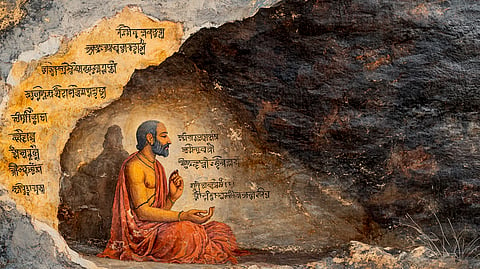- Commentary
- History Vignettes
- Notes on Culture
- Dispatches
- Podcasts
- Indian LanguagesIndian Languages
- Support

ON 5 JANUARY 1952, the legendary D.V. Gundappa delivered a masterly lecture on the immortal Sanskrit poet and grammarian, Bhartrhari, at the Gokhale Institute of Public Affairs, Bangalore. It remains one of the finest expositions on the life, poetry and genius of Bhartrhari.
The unedited extracts of the lecture will be published as a series beginning with this episode. Unfortunately, the full lecture has not survived. It is available in the fifth volume of Selected Writings of DV Gundappa published by the Gokhale Institute of Public Affairs, Bangalore.
Happy reading!
AMONG WELL-KNOWN SANSKRIT POETS, I would indeed say among great Sanskrit poets, Bhartrhari takes rank next after Valmiki, Vyasa and Kalidasa. The first two are epic poets and, in a sense, the foundation-builders of our civilization and culture. Then comes Kalidasa famous as a dramatist.
Next only to him in popularity is Bhartrhari the lyrico- epigrammatist. While the first three are creative artists, Bhartrhari is, if I may coin an expression, an alembic artist. He has distilled for us the ethos of the Ramayana and the Mahabharata from which Kalidasa too took his material.
Bhartrhari has summed up the messages of the ancients in his three Shatakas or Centuries of Epigrams. Though he is not to be placed by the side of the epic poets, he is not of any the less value to us as the exponent of primary impulses of the Hindu mind and its ideals in life. What Vyasa is to the elect, Bhartrhari is to the common man. Bhartrhari’s words come home to young people as well as to old. His appeal is so simple, so pointed and so direct.
Very little is known for certain about the time and the place of Bhartrhari. Many stories are current, but with no claim to be regarded as in any degree historical. Scholars place him somewhere between the first and the sixth century AD. It seems certain that he lived before Kumarila Bhatta and Shankaracharya, — perhaps a little later than Kalidasa. It seems reasonable to take fifth-sixth century as the time of Bhartrhari.
It was the period of the break-down of the Gupta Empire in the North. The Guptas, of the line founded by the great Chandragupta, had risen to a great height in power and prosperity. But as Bhartrhari has sadly cautioned us, empires have a way of crumbling down irreparably. Rivals rose in the neighbourhood for the Guptas; and invading hordes of Huns came rushing from Central Asia. Their ravages could not have left the civil and social life of the country untouched. Political un- settlement must have been followed by some unsettlement of morals and manners.
It is never easy to say whether the conquest of a country by a foreigner was the effect of a pre-existent demoralization there or the cause of a demoralization that followed after. It is quite possible that both conditions apply together in a case. The age that some verses of Bhartrhari point to was one of decay of letters and culture and fall from ideals and loss of the scene of relative values. He lived in times that paid little respect to what he held high.
According to tradition Bhartrhari lived in Central India. He is said to have indeed ruled the country as king from Ujjayini in Gwalior, being the elder brother of the famous king Vikramarka. There are many Vikramas famed as kings in our history; and to which of them, Bhartrhari was brother, historians have been puzzled to decide.
Skandagupta, the last of the great Gupta kings, had taken the title of Vikramaditya and his reign was from 455 to 467. It was the period of attack by the Huns. Whether himself a king or not, and whether the brother of a king or not, there seems to be no reason to deny to the region of Ujjayini the credit for having been the home of Bhartrhari in the fifth-sixth century AD. There is a verse attributed to Bhartrhari:
अग्रे गीतं सरसकवयः पार्श्वयोर्दाक्षिणात्या: ||
agre gītaṃ sarasakavayaḥ pārśvayordākṣiṇātyā: ||
which suggests that he was partial to poets belonging to South India, the implication being that he was himself a northerner or a non- southerner in any case. Incidentally, this verse shows that commerce in letters and culture was common between the North and the South at that time, 1400 years ago.
To be continued
The Dharma Dispatch is now available on Telegram! For original and insightful narratives on Indian Culture and History, subscribe to us on Telegram.
